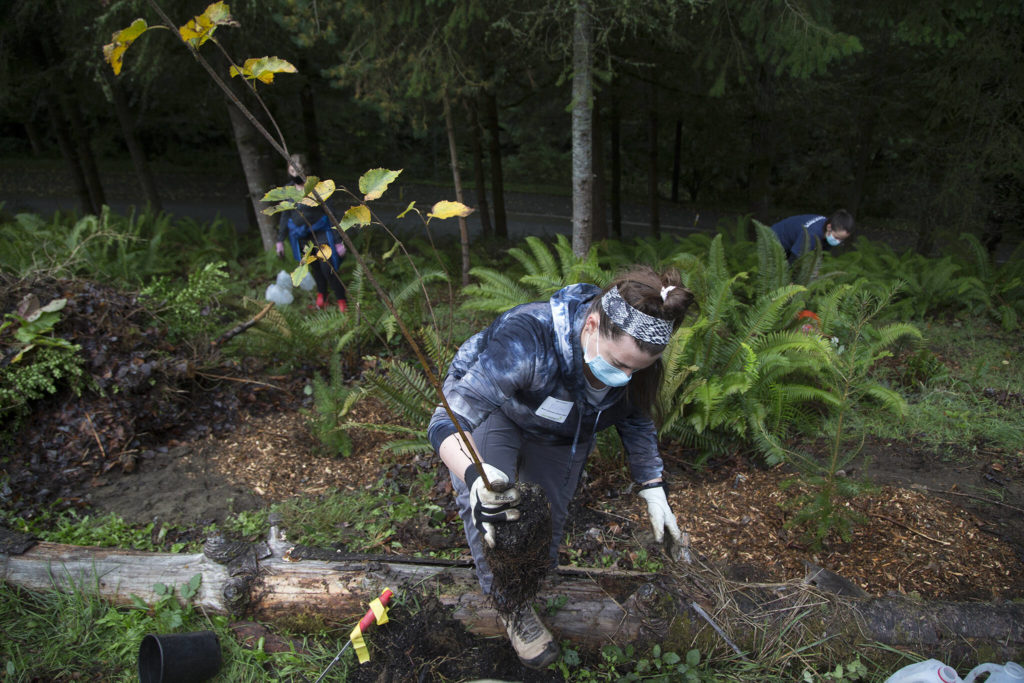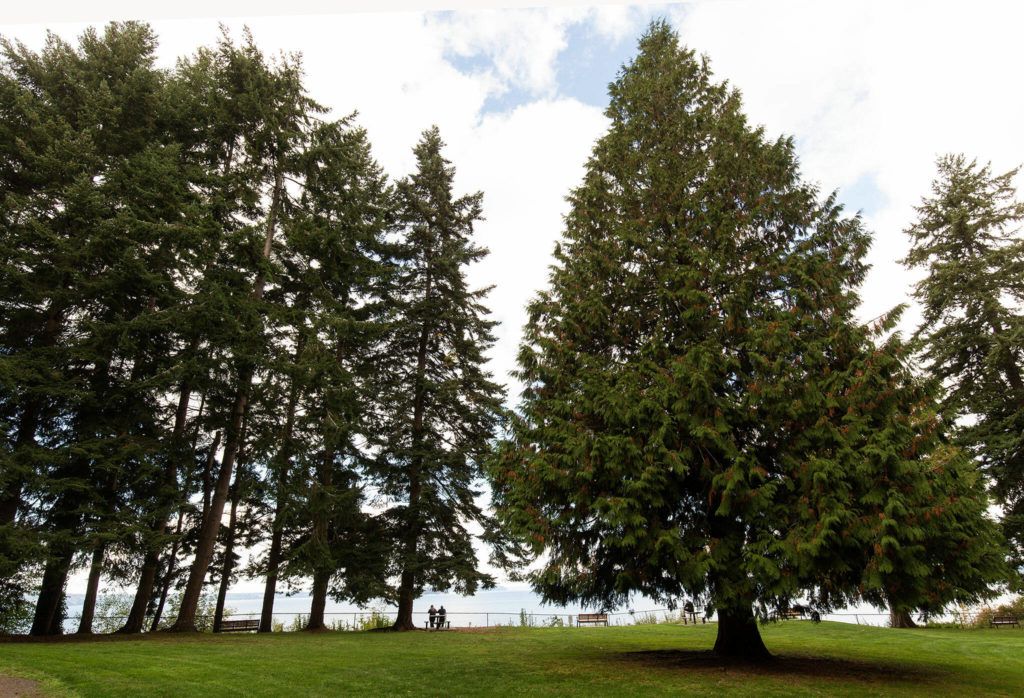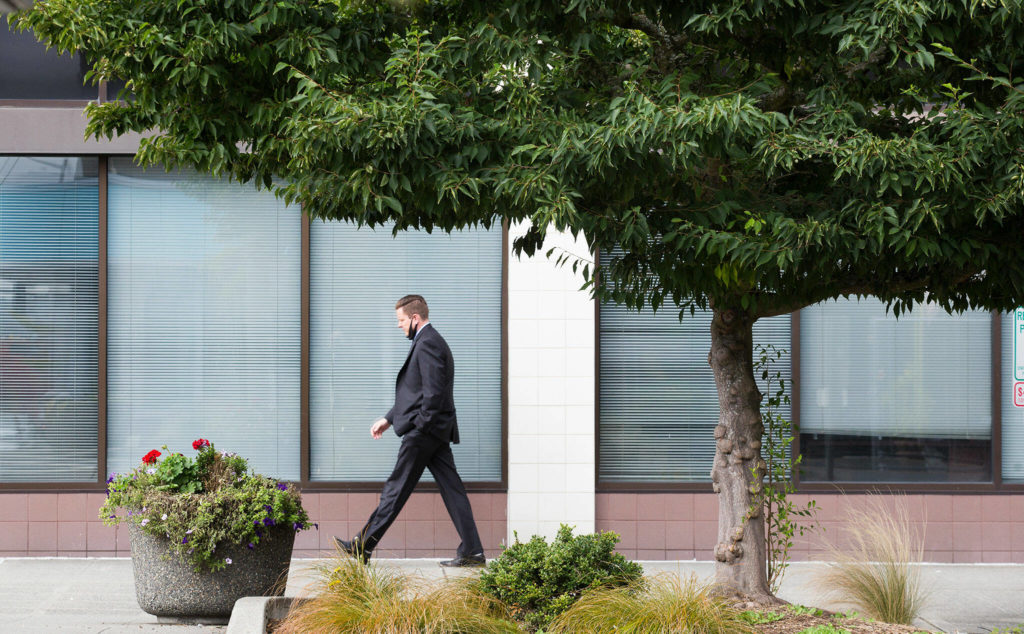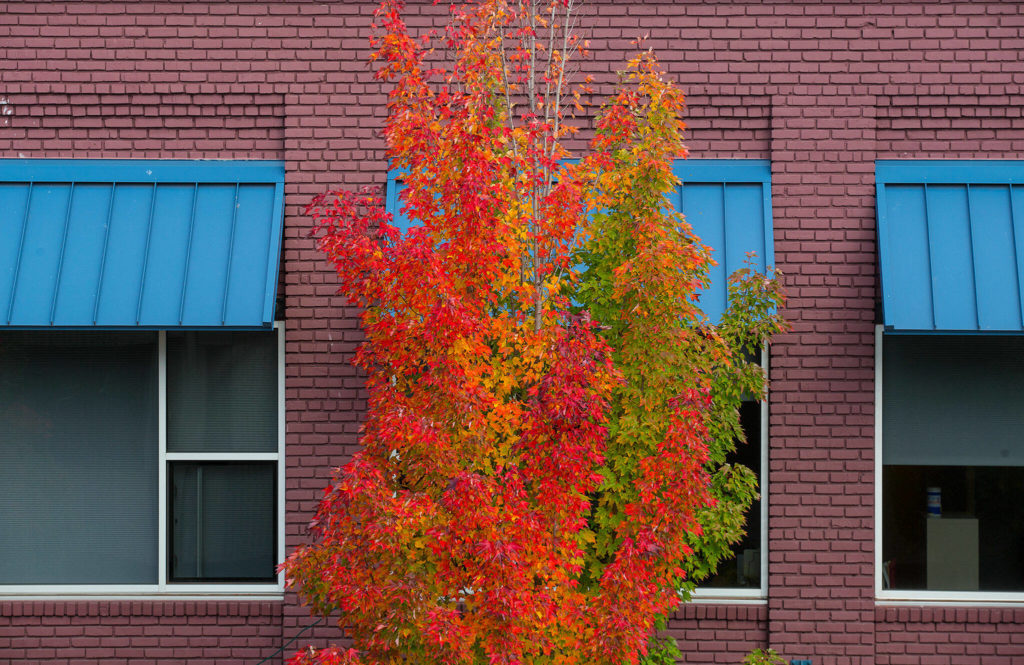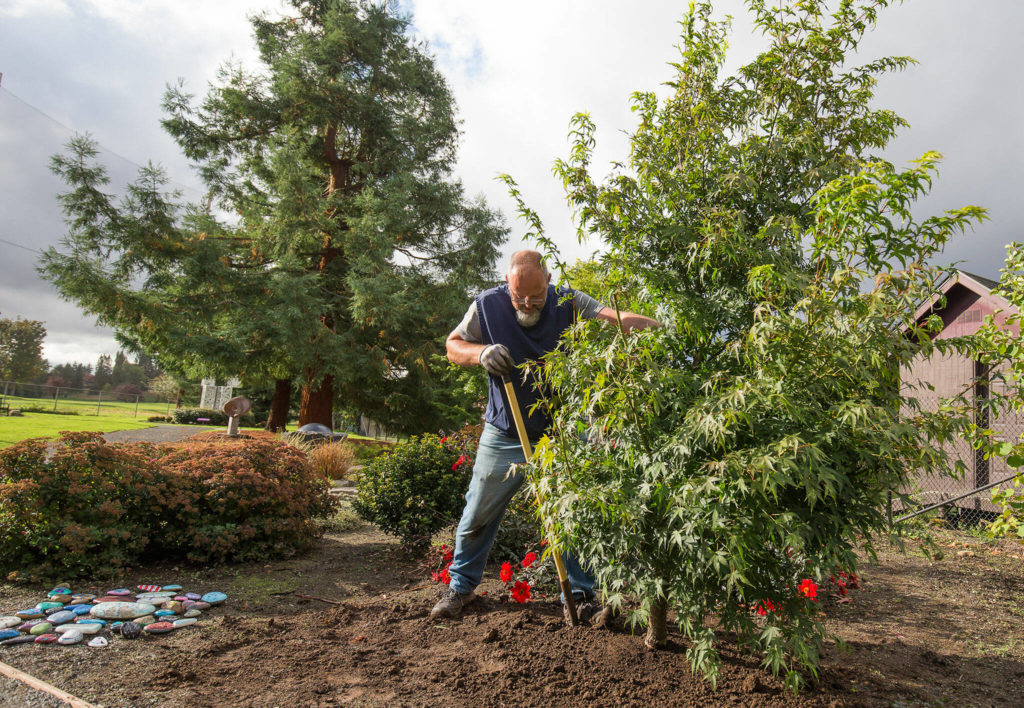This is the first of three Daily Herald stories looking at how climate change threatens our urban trees and highlights their value in helping us cope with it.
Climate change is coming for our neighbors, the trees.
Intense heat and rainfall can stress and kill towering native conifers as well as species we’ve imported for their color and grace. As they suffer, city dwellers suffer. Because trees help humans cope with climate change.
Trees — especially big ones — capture and store carbon dioxide, one of the greenhouse gases driving human-caused climate change. Leaves trap particulates from fires and vehicle exhaust. Roots intercept stormwater. Trees release cooling water vapor and offer shade. They provide respite during extreme heat waves, which kill more Americans than any other weather event.
If you have a yard with a big maple, you’re less likely to need air conditioning. But as Snohomish County’s population surges, more people are living in multifamily buildings or houses on small lots. That’s a boon for A/C companies and a bummer for towering trees.
“I have been selling plants for over three decades, and we have gone from selling hundreds of shade trees like oaks and sycamores and maples and large conifers to only a handful,” said Steve Smith, owner of Marysville’s Sunnyside Nursery. “The lots are simply too small for a tree that will grow 60 feet tall.”
The downsizing of private property, he added, makes it especially important to protect trees in public spaces.
The good news: Climate-driven weather extremes are shining a spotlight on the value of urban trees.
Trouble in the Evergreen State
The past five years of unusually warm summers have the attention of Raymond Larson, curator at the 230-acre University of Washington Botanic Gardens. Species that staff experts never had to think about before are suffering and, in some cases, dying. Some are natives.
“Here on the west side” of the state, “we’ve had a lot of mortality in Western hemlocks,” he said of Washington’s state tree. “They’re a lot more sensitive to water levels than some of our other native trees.”
The ill-fated hemlocks may be 80 feet tall and 80 to 100 years old — still in their prime, Larson said. They start dying from the top and, like other species under stress, set more cones than usual.
The same thing is happening with the even-larger Western red cedars. The shallow-rooted trees seem especially hard-hit when hot summers come paired with unusually wet winters, said Tom Smiley, a researcher with Bartlett Tree Research Lab.
“A lot of Western red cedar problems started in a year of high water,” Smiley said. “The cedar is falling out of favor with a lot of arborists because of climate-related issues. I don’t recommend stopping (its use), but you have to choose your locations carefully, especially in an urban environment.”
Arborist Craig Callies, an Everett Arboretum board member, has most often noticed severely singed cedars south of Seattle. But he keeps an eye out locally for signs of stress in large evergreens, including firs. One indicator is droopiness, what tree experts call flagging. Another is large clusters of dried needles, instead of the normal autumn scattering of brown in the branches.
Callies works for the Everett Public Works Department. He also has his own business helping property owners with troubled trees. One task is spraying for bronze birch borers. The half-inch beetles are homing in on the popular landscaping species.
It used to be you could plant a birch and not worry about it, said Larson of the UW Botanical Gardens. But now these beetles, attracted to a tree’s stress hormones, are becoming a problem.
“They have decimated half of our birch collection,” he said. “You will start to see a gradual flagging, or leaves at the top start to shrivel. You have to do an expensive treatment annually.”
Like humans, the beetles are attracted to bright bark. The popular European white bark birch and Himalayan birch are most at risk, so horticulturists recommend other varieties. The most resistant, Larson said, is the river birch with its curling orange bark.
Tree buyers can get suggestions for drought-friendly plants at nurseries and arboretums, and browse compendiums such as the City of Seattle Master Tree List. At greatplantpicks.org, they will find smaller trees among the extensive options recommended for Northwest maritime gardens. Arborday.org has many resources. But no one can predict how the new weather extremes will affect a species.
“Our industry hasn’t started promoting trees that do better in warmer summers,” said Smiley, the arboricultural researcher. “Part of that is, we don’t know.”
Horticulturalists have long advised planting native trees because those species have adapted to the local environment. But this isn’t your grandmother’s Pacific Northwest, or even your father’s, so that advice is changing. Some of the most tolerant species are ones that learned to adapt to inhospitable environments, said the UW’s Larson. “Black tupelo is native to the Southeast, but it actually does pretty well in drying conditions,” he said.
Go big and take care
Arborists recommend planting a variety of trees and shrubs as a defense against a changing climate and insect infestation. If you have room for a big, carbon-storing, shade-giving tree, plant one.
“It’s aggravating when I see a big, open space and they plant a little dogwood in what could be a good space for a big oak or elm,” said Jim Barborinas, owner of Urban Forest Nursery in Mount Vernon. “People should plan for the ultimate tree.”
When someone asks Barborinas if a species is drought tolerant, “I give them my spiel about soils.” A tree planted in healthy soil, it’s more likely to survive stress. So, the first step in planting a tree, even before choosing it, is making sure there is decent topsoil on the site. And enough of it.
The next step is making sure it has adequate water. Common practice in this region has been to water a tree or shrub regularly for the first year, then rely on rain. But with longer, hotter summers, that’s often not enough.
“In six months, we received less than seven inches of rain,” Sunnyside nursery’s Smith said of 2021 conditions. “Considering that our municipalities recommend we apply one inch of water a week to keep our landscapes healthy, it should be a no-brainer that things are going to go up in smoke.”
Other arborist advice: Ideally, water before trees look stressed. Don’t wait until a conifer gets brown, when it could be too late to save. Watch the shrubs — when your rhododendrons look scorched, it’s time to water everything. Use a soil moisture gauge to make sure plants are getting adequate water without wasting it. Smiley recommends measuring six inches down.
Help from the Statehouse
While residents cope with suffering yard trees, local governments face bigger challenges. They have to keep parks thriving and tend to trees in downtown pots and congested rights-of-way. They need to know how much tree canopy residents have, how much they need and whether it is distributed fairly.
Last April, Washington legislators offered help by approving House Bill 1216. An update of the 2008 Evergreen Community Act, the bill is a boost to the Department of Natural Resources’ Urban and Community Forestry Program. It provides $2.68 million in the 2021-23 budget for staff and for grants to aid local governments, tribes, schools and nonprofits.
Previously, the urban forestry program relied on grant money it passed along from the U.S. Forest Service, said program manager Ben Thompson.
“We’ve always been a small program with a large constituency,” he said, noting community concerns such as wildfire vulnerability and onslaughts of pests. “The new law will allow us to hire more staff and promote the services we provide.”
One program goal is to get technical expertise into every community. Most Washington cities lack a staff forester or arborist, Thompson said.
At the urging of state Public Lands Commissioner Hilary Franz, half of state grant money will go to help people who are most vulnerable to climate change and the other health stressors that trees can help alleviate. They often live in heavily developed “heat islands,” like those concentrated along Interstate 5 at the south end of Snohomish County. Tree-lined streets and countryside have been replaced with apartment complexes, heat-absorbing pavement, subdivisions and now the extension of the Sound Transit light rail system.
An important tool in the urban forest grant-giving process will be the Department of Health’s Environmental Health Disparity Map. Layered with tree canopy maps, it can display neighborhoods where adding trees would have the most benefit. Thompson said roughly $450,000 — split up into $5,000-$20,000 grants — will be available for aerial tree canopy surveys, street-level tree inventories and projects that identify urban forestry priorities. Another $200,000 will be available for tree planting, maintenance, public education and other projects.
Numbers and stewardship
American Forests, a national conservation group, recommends a 40% tree canopy for healthy cities. The two most recent estimates of tree canopy in Snohomish County’s unincorporated growth areas are 24.1% and 37.7%, according to the county’s 2020 Tree Monitoring Report. County regulations require large-scale developments to plan for 30% canopy be in place 20 years after construction.
In the county’s largest city, the estimated tree canopy for public and private property combined is 25%, Everett spokesperson Kimberley Cline said.
“We are working on establishing a no-net-loss goal as well as developing plans to help grow the canopy,” she said. “We are having our tree canopy assessed through the Parks, Recreation and Open Space Plan, which is set to be adopted sometime next spring.”
The assessment is being done by Forterra, a nonprofit at the forefront of urban tree conservation. It has partnerships with Everett, 13 other Puget Sound cities, and Snohomish County. Its Green Partnership Program has focused on forested parks and natural areas, including a 10-area assessment for the Snohomish County Healthy Forests Project.
Concern about climate change is woven into Forterra’s activities, said Joanna Nelson de Flores, Forterra’s managing director of restoration and stewardship. For example, trees, shrubs and groundcover are planted more densely, because some won’t survive. Care is taken to ensure plants are watered during longer, hotter summers.
Forterra shops for drought tolerant plants locally, but is aware that plant-hardiness zones are changing. “Some seed stock is more genetically adopted to warmer climates,” Nelson de Flores said. “The larger restoration community is considering this.”
For boots on the ground, Forterra relies on a network of forest stewards who supervise other volunteers. Steward Amanda Goffard is gratified by the progress being made at Forest Park, Everett’s largest park. Workers cleared areas choked by Himalayan blackberries and other invasives, then returned to plant native species.
“They’ve been making a huge difference,” she said.
Goffard’s 2013 undergraduate thesis was a stewardship plan for Thornton A. Sullivan Park near Silver Lake. She now works in water treatment and stormwater management, and became a steward as a way of getting back to forest restoration. It’s a passion inspired by growing up in southern Snohomish County.
“I grew up in Lynnwood and watched the whole area develop,” she said. “I saw forested areas disappear, places I played in as a kid. I watched it happen, and I wanted to help.”
Julie Titone is an Everett writer who can be reached at julietitone@icloud.com. Her stories are supported by the Herald’s Environmental and Climate Reporting Fund. To contribute, go to HeraldNet.com/climatedonate.
About this series
This three-part Daily Herald series looks at how climate change threatens our urban trees and highlights their value in helping us cope with it.
This story: Two of the Pacific Northwest’s most iconic trees, the Western red cedar and hemlock, are most stressed by new extremes in heat and rainfall. As regional conditions rapidly evolve, experts are changing their advice about what to plant.
Part 2: A local campaign to protect urban trees finds permitting regulations for developers sorely lacking. Its efforts may result in a more tree- and climate-friendly Snohomish County Comprehensive Plan.
Part 3: What’s a forest garden? A great way to grow edibles during a time of climate change, says a conservation planner. A Bothell man incorporates the idea into his all-out effort to turn a yard into a climate-friendly food system.
Environmental Reporting Fund
If you’d like to see more stories like this, donate to The Daily Herald’s Environmental and Climate Change Reporting Fund in partnership with Journalism Funding Partners. Go to heraldnet.com/climatedonate.
> Give us your news tips. > Send us a letter to the editor. > More Herald contact information.Talk to us
Gallery


